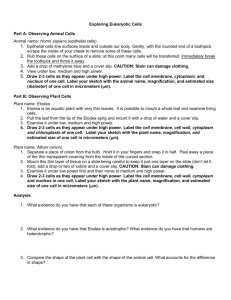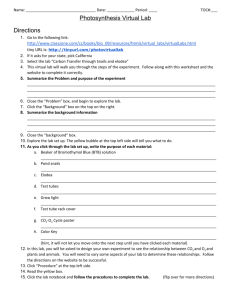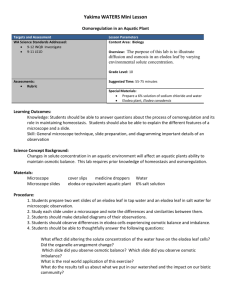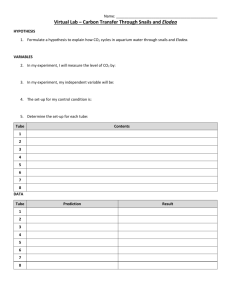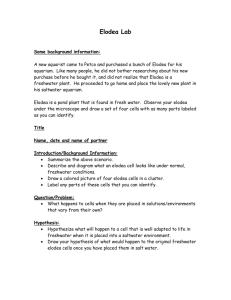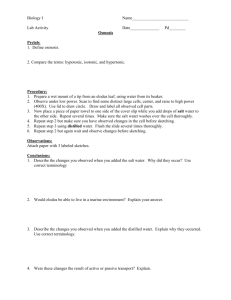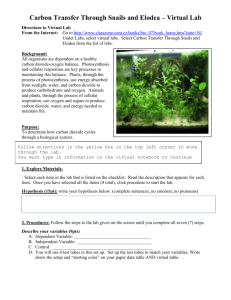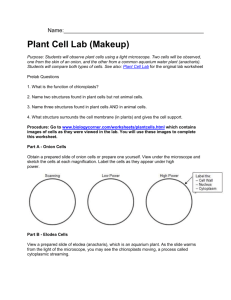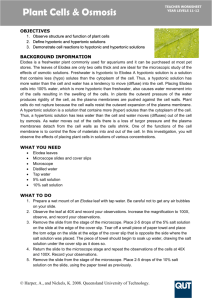OBSERVING PLASMOLYSIS IN ELODEA
advertisement
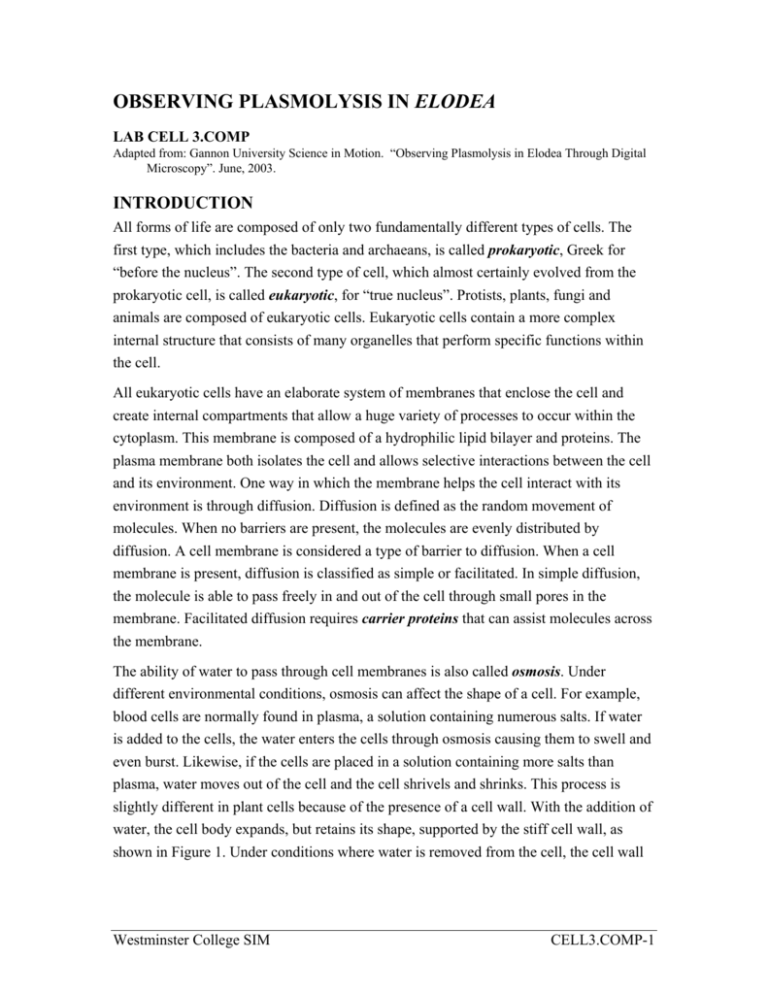
OBSERVING PLASMOLYSIS IN ELODEA LAB CELL 3.COMP Adapted from: Gannon University Science in Motion. “Observing Plasmolysis in Elodea Through Digital Microscopy”. June, 2003. INTRODUCTION All forms of life are composed of only two fundamentally different types of cells. The first type, which includes the bacteria and archaeans, is called prokaryotic, Greek for “before the nucleus”. The second type of cell, which almost certainly evolved from the prokaryotic cell, is called eukaryotic, for “true nucleus”. Protists, plants, fungi and animals are composed of eukaryotic cells. Eukaryotic cells contain a more complex internal structure that consists of many organelles that perform specific functions within the cell. All eukaryotic cells have an elaborate system of membranes that enclose the cell and create internal compartments that allow a huge variety of processes to occur within the cytoplasm. This membrane is composed of a hydrophilic lipid bilayer and proteins. The plasma membrane both isolates the cell and allows selective interactions between the cell and its environment. One way in which the membrane helps the cell interact with its environment is through diffusion. Diffusion is defined as the random movement of molecules. When no barriers are present, the molecules are evenly distributed by diffusion. A cell membrane is considered a type of barrier to diffusion. When a cell membrane is present, diffusion is classified as simple or facilitated. In simple diffusion, the molecule is able to pass freely in and out of the cell through small pores in the membrane. Facilitated diffusion requires carrier proteins that can assist molecules across the membrane. The ability of water to pass through cell membranes is also called osmosis. Under different environmental conditions, osmosis can affect the shape of a cell. For example, blood cells are normally found in plasma, a solution containing numerous salts. If water is added to the cells, the water enters the cells through osmosis causing them to swell and even burst. Likewise, if the cells are placed in a solution containing more salts than plasma, water moves out of the cell and the cell shrivels and shrinks. This process is slightly different in plant cells because of the presence of a cell wall. With the addition of water, the cell body expands, but retains its shape, supported by the stiff cell wall, as shown in Figure 1. Under conditions where water is removed from the cell, the cell wall Westminster College SIM CELL3.COMP-1 Observing Plasmolysis in Elodea maintains its shape, but the cell membrane pulls away from the cell wall and the cell body is reduced in size. This shrinking of the cell body is called plasmolysis. In this exercise, you will use a digital microscope to compare the cell body and cell walls of normal plant cells. Addition of a salt solution to these plant cells will demonstrate plasmolysis. Using a computer program, you will analyze the difference in the volume of these two types of cells to quantitate the effect plasmolysis has on the cell body. Error! Figure 1. Diffusion of Water in Plant Cells Cell membrane expands but retains shape because of cell wall. Cell wall H2O Cell membrane Cell membrane shrinks and pulls away from cell wall (plasmolysis). Nucleus H2O PURPOSE This activity is designed to have the student demonstrate proper microscope techniques, create a wet mount of an Elodea leaf, use computer software to capture still images for analysis, and quantify the area of normal and plasmolyzed Elodea cell bodies. EQUIPMENT/MATERIALS Digital microscope Elodea or Anacharis leaf Distilled Water Forceps Kimwipes Dell Laptop with Motic Images 2000 v.1.3 Glass Slide and Cover Slip 6% Salt Solution Disposable pipets SAFETY • Use caution handling the glass slides and microscopes. Westminster College SIM CELL3.COMP-2 Observing Plasmolysis in Elodea PROCEDURE MICROSCOPE AND COMPUTER CONNECTIONS 1. Carefully remove the digital microscope from its carrier. There are 3 connectors which accompany the microscope. One is the black power cord that plugs into the black Motic adaptor. The Motic adaptor plugs into the back of the microscope. A tan USB cable connects the digital microscope to the USB port on the laptop. 2. Connect the microscope adaptor and power cord and turn the microscope on. The light at the base of the microscope should turn on. Set the light at its brightest setting using the dial at the bottom right hand side of the microscope. 3. Connect the power cord and adaptor for the laptop and start the computer. When the first dialogue box appears, choose “Workstation only”. In the user name box type “sim”. The password is “sim” as well. Both of these are case-sensitive. 4. On desktop, locate the “Motic Images 2000 1.3” icon. Double-click the icon to open the Motic 1.3 program. Leave the computer like this until you are ready to view your slide. PREPARING A MICROSCOPE SLIDE OF ELODEA 1. You have been given a glass slide and a cover slip. Obtain a single leaf of the Elodea plant from your instructor. The smaller the leaf, the easier it is to prepare the slide for viewing. 2. Use the forceps to place the leaf in the center of the flat side of the glass slide. Flatten the leaf as much as possible. Use the pipet to place one or two drops of distilled water onto the leaf so it is covered, as shown in Figure 2A. Figure 2. Diagram of Slide Preparation A. Elodea water leaf glass slide Westminster College SIM B. cover slip glass slide C. glass slide CELL3.COMP-3 Observing Plasmolysis in Elodea 3. Figure 2B shows how to place one edge of the cover slip near the leaf so that it is in contact with the water on the slide. Hold the cover slip at a 45º angle and gently lower it onto the leaf, trying to avoid trapping air bubbles, as in Figure 2C. It may take a couple of tries before you achieve the desired results. SAVING A STILL IMAGE OF NORMAL ELODEA CELLS 1. First look at your objective lenses and make certain that you use the lowest power lens (4X). Now use the coarse adjustment to bring the objective lens as close as you can to the stage. Look at the slide and determine where the Elodea leaf is located, and place it in the center of the hole on the stage. 2. Find the Toolbar at the top of the Motic Images window and select File. Halfway down the list you will select the “Capture Window” option (Ctrl M). This will open a second window in the program that will display a real time image of your Elodea slide. (The focus of the image may be slightly skewed from what you see in the microscope objective. Focus to what you see on the computer screen.) 3. Using the coarse adjustment, focus away from the specimen until it is clear and sharp, using the fine adjustment as needed. Notice that by turning the fine adjustment back and forth, you will focus on different depths of the specimen. This will be more apparent with higher magnification objective lenses. 4. Choose a portion of the Elodea leaf to observe in more detail. Center it in the field of view and place the slide clips over the slide to hold it in place while performing the next few steps. Rotate the objective nosepiece to bring the medium power objective (10X) into position. Notice three things here: a. The image will nearly be in focus without touching the focus knobs. Objectives matched like this are said to be parfocal. Use the fine focus knob to bring the image into focus on the computer screen. b. The distance between the objective lens and the slide is shorter than with the previous lens. This loss of working distance increases as the power of the lens increases. It is possible to easily lower a high power lens right through a slide. The slides aren’t such a big loss, but the objective lenses can cost hundreds of dollars. Therefore, be careful. c. The image doesn’t appear as brightly illuminated with the higher power lens. Stronger lenses need more light, so turn up your rheostat and adjust your substage diaphragm accordingly. 5. Rotate the objective nosepiece to bring the high power objective (40X) into position. Be careful not to bump the objective lens on the glass slide; lower the Westminster College SIM CELL3.COMP-4 Observing Plasmolysis in Elodea stage if necessary. At this power of magnification, individual cells will appear 3dimensional. Use the fine focus knob to bring a cross-section of 4 or 5 cells clearly into focus on the computer screen. 6. Observe the cells at this power of magnification. The cell membrane will be almost indistinguishable from the cell wall of the cell. The chloroplasts should be visible as small green balls. Many of these will be moving in and out of focus around the cytoplasm. 7. To capture a still image of the normal Elodea cells, find the camera icon on the left hand side of the Motic DS Capture window. This is the “Capture Current Image” icon. Click this icon to take a still image of the cells. To save this image, click on “File” on the upper tool bar. Within this menu, select “Save As”. Label the image “Normal Cells”. Save the picture to the desktop. Do this by clicking on the “▼“ at the right-hand end of the “Save in:” window. Select “Desktop” from this list. Then click the “Save” button. Check that the file is on the desktop before proceeding to the next section. PLASMOLYSIS OF ELODEA CELLS 1. Open a new capture window as described in Step 2 of the previous section. 2. Without removing the slide from the microscope stage, add several drops of 6% salt solution with a dropper to one side of the cover slip (Fig. 3A). Try not to disturb the slide while performing this step. Watch the computer screen for one or two minutes as some of the salt solution diffuses under the cover slip. You will start to see the cell membrane pull away from the cell wall as water is lost from the cell. 3. Place the edge of a Kimwipe gently against the side of the cover slip opposite the salt solution, as shown in Figure 3B. This will wick the 6% salt solution completely under the cover slip without disturbing the slide preparation. Figure 3. Diagram of Plasmolysis Procedure A. 6% salt solution glass slide Westminster College SIM Kimwipe B. movement of salt solution glass slide CELL3.COMP-5 Observing Plasmolysis in Elodea 4. The Elodea cells should look very different at this stage. The cell membrane will be clearly visible as it has pulled away from the cell wall. The chloroplasts will be compacted within the cell body. Use the fine focus knob to bring a cross-section of 4 or 5 cells clearly into focus on the computer screen. 5. Capture a still image of the Elodea cells in salt solution as described in Step 7 of the previous section. Label the image “Plasmolysis”. Again, save the picture to the desktop. Check that the file is on the desktop before proceeding to the next section. MEASURING AVERAGE AREA OF ELODEA CELLS 1. Open the “Normal Cell” image file. 2. Go to “Measure” on the tool bar and select “Irregular”. The cursor will become the shape of a cross. 3. Place the center of the cross on the plasma membrane of any complete cell. Left click and hold the button down while tracing the perimeter of the cell with the cursor. After tracing the perimeter, release the left mouse button. A box will appear that displays the area (in micrometers squared, µm2) and perimeter (in µm) of that particular cell. Record the area in the data table marked “Elodea Cells in Water”. 4. Repeat Step 3 to trace four more cells (a total of 5). Each time, record the area in the data table. 5. Open the “Plasmolysis” image file. 6. Repeat Steps 2 through 4 for the cells treated with the salt solution. Remember that you are tracing the cell membrane, not the cell wall. Record the area of the cell in the data table marked “Elodea Cells in 6% Salt Solution”. Reference William K. Purves and Gordon H. Orians. Life, The Science of Biology. “Chapter 5: Membranes”. Willard Grant Press. 1983. pp. 118-123. Westminster College SIM CELL3.COMP-6 Observing Plasmolysis in Elodea Name ________________________ DATA SHEET Name ________________________ Period _______ Class ___________ Date ___________ OBSERVING PLASMOLYSIS IN ELODEA DATA TABLES Elodea Cells in Water Area (µm2) Cell Number Avg. Cell Area Elodea Cells in 6% Salt Solution Cell Number Area (µm2) Avg. Cell Area Percent Cell Body Area Calculation: 100 X Avg. Cell Area Plasmolyzed Cells = % Reduction of Cell Body Area Avg. Cell Area Normal Cells QUESTIONS 1. What are the two types of diffusion? Describe the difference between them. 2. What is a cell membrane and how does it benefit the cell? Westminster College SIM CELL3.COMP-7 Observing Plasmolysis in Elodea 3. In terms of diffusion, describe why the cell body shrinks when the salt solution is added. 4. Why is it important for Elodea to have so many chloroplasts? 5. Why is the use of a digital microscope so important for this lab exercise? Westminster College SIM CELL3.COMP-8

